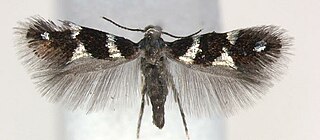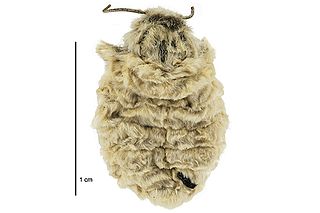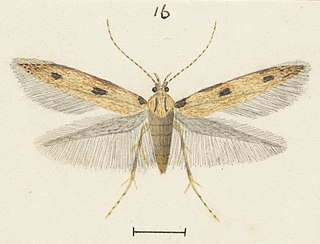
Edward Meyrick was an English schoolmaster and amateur entomologist. He was an expert on microlepidoptera and some consider him one of the founders of modern microlepidoptera systematics.

The Heliozelidae, commonly known as shield-bearer moths, are a family of small, day flying monotrysian moths distributed worldwide. The larvae of most heliozelid species are leaf miners who cut distinctive shield-shaped cases from the surface of the host leaf, hence the common name. Some species are considered pests of commercial crops such as grapevines, cranberries, and walnuts. The taxonomy of this family is poorly understood.

Metacrias is a genus of moths in the family Erebidae. All species are endemic to New Zealand.
Dryadaula are a genus of moths belonging to the family Tineidae. It was described by Edward Meyrick in 1893, and it belongs to the subfamily or family Dryadaulidae, according to most recent taxonomies.

Pseliastis is genus of moths in the family Heliozelidae, first described by Edward Meyrick in 1897. Three species are currently described, all endemic to Australia.
Pseliastis trizona is a species of moth in the family Heliozelidae, described by Edward Meyrick in 1897. It is endemic to Tasmania, Australia.

Pseliastis xanthodisca is a species of moth in the family Heliozelidae, described by Edward Meyrick in 1897. It is endemic to Tasmania, Australia.

Labdia anarithma is a moth of the family Cosmopterigidae. It was described by Edward Meyrick in 1888. It is found in New Zealand and throughout Australia. Adults are on the wing from December to March and are day flying. They have been collected by sweeping bracken fern.
Chloroclystis catastreptes, the green and brown carpet, is a moth in the family Geometridae. It was described by Edward Meyrick in 1891. It is found in Australia.
Ascalenia exodroma is a moth in the family Cosmopterigidae. It was described by Edward Meyrick in 1897. It is found in Australia, where it has been recorded from Queensland.
Ascalenia semnostola is a moth in the family Cosmopterigidae. It was described by Edward Meyrick in 1897. It was described from the Australian state of New South Wales, but has also been recorded from South Africa.
"Elachista" cataptila is a moth with an unclear taxonomic position. It was described by Edward Meyrick in 1897. It is found in Australia, where it has been recorded from Western Australia.
Elachista demogenes is a moth in the family Elachistidae. It was described by Edward Meyrick in 1897. It is found in Australia, where it has been recorded from South Australia.

Coracistis is a monotypic moth genus in the family Elachistidae. Its only species, Coracistis erythrocosma, is found in Australia, where it has been recorded from Victoria. Both the genus and species were first described by Edward Meyrick in 1897. It
Notodryas aeria is a moth in the family Epermeniidae. It was described by Edward Meyrick in 1897. It is found in Australia, where it has been recorded from the Australian Capital Territory, New South Wales, Queensland, Tasmania and Victoria.
Megacraspedus chalcoscia is a species of moth of the family Gelechiidae. It was described by Edward Meyrick in 1904. It is found in Australia, where it has been recorded from South Australia and Western Australia.
Illidgea epigramma is a moth in the family Xyloryctidae. It was described by Edward Meyrick in 1890. It is found in Australia, where it has been recorded from the Australian Capital Territory, New South Wales, Queensland and South Australia.

Atomotricha is a genus of moths of the family Oecophoridae. The species in this genus are endemic to New Zealand.
Heosphora is a genus of moths in the family Pyralidae. The genus was first described by Edward Meyrick in 1882. The type species is Anerastia psamathella Meyrick, 1879, designated as such by George Hampson in 1901. All Heosphora species are found in Australia.
Heosphora psamathella is a moth in the family Pyralidae. The species was first described by Edward Meyrick in 1879, as Anerastia psamathella, from a male specimen collected in Sydney, New South Wales, and was moved to the genus Heosphora as its type species by George Hampson in 1901. It is found in Australia.






